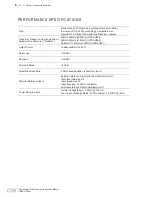
Enhanced FM Synthesizer Instruction Manual
IM10-OS3AH
29 - 71.4 MHz - Theory of Operation
8
The fi eld effect transistor Q5 forms part of the
negative resistance VHF amplifi er oscillator that
is tuned on-frequency by the combination of the
resonator L5 and the total capacitive reactance
presented across L5 through capacitors C62,
C63, C64, C23 (Select), variable capacitor C24,
and varactor diodes D1 and D2. Fine frequency
adjustment is obtained via the multi-turn trimmer
capacitor C24 in conjunction with the coarse
frequency jumper selections JU2, JU3 and
JU4. Select capacitor values are chosen to
position the operating frequency in one of three
bands: 29-38MHz, 38-50MHz or 50.4-71.4MHz.
Varactor diodes D1 and D2 provide oscillator
frequency control. The PLL control voltage,
at the output of the low-pass loop fi lter (TP4),
controls the VCO frequency through the reverse
biasing of varactor diodes D1 and D2. The PLL
control voltage can range between ≈ +0.5VDC
and +4.5VDC and is nominally set to ≈ +2.3VDC
at the synthesizer centre frequency. Setting
of the PLL control voltage test point (TP4) is
achieved by adjusting fi ne frequency variable
capacitor C24 combined with binary weighted
lumped capacitor coarse frequency jumpers
(JU2, JU3, JU4). External baseband frequency
modulation is provided through connection
P1 and a voltage divider network formed by
R21 and R22. A large signal division ratio,
established by the resistive dividers R21 and
R22, allows low deviation (less than 5kHz) direct
frequency modulation of the VCO output signal.
The PLL low-pass fi lter is formed by SELECT
components C37, C38, C39, C45, R32 and
R36. The loop fi lter response is optimized
for switching time, noise and modulation
requirements specifi c to each sub-band within
the 29-71.4MHz frequency range. The SELECT
components (including the loop fi lter) can be
found in tabular format on the VHF OS(R/T)-3H
29-71.4MHz Analog Board Schematic diagram.
RF output power is taken from the source
of Q5 and amplifi ed/buffered by U11. U15
provides further amplifi cation and isolation
while delivering approxi10dBm into a
six-pole low-pass notch formed by C53, C57,
C58, C59, L11 and L13. The six pole output
fi lter, with a cutoff frequency of 50MHz for
models OST-3H035 and OST-3H045 or 80MHz
for the OSR-3H061 effectively eliminates
output harmonics. SMB connector J2 provides
interconnection to the companion transmitter or
receiver with an output level of +5dBm ±2dBm.
The 9.6 or 10.0MHz reference source is divided
down to establish a channel selection step
size of 5.0 or 6.25kHz. A third order passive
loop fi lter comprised of C37, C38, C39, C45,
C49, R36 and R32 are employed to achieve
the required noise performance, modulation
and worst case switching time of 50ms. A small
sample of RF energy is coupled from the VCO
output buffer U16 to the synthesizer IC U10
prescaler input (pin 11). FM modulation of
the VCO from approximately 100Hz to 3kHz
is achieved through the baseband input pin
P1-1 on the Digital Board. A 1kHz sine wave
with a level of approximately 400mVrms at
P1-1 provides FM deviation of 3.0kHz. SMB
connector J2 provides an RF output level
of approxi5dBm into a 50Ω load.
An optional low frequency modulation input
is provided through connector P1-18 on the
digital board, and routed to the analog board via
connector P3. This modulation input is coupled
to a low impedance DC coupled source. The
input provides a phase modulated bandwidth
from 0Hz (DC) to the PLL loop fi lter bandwidth.
This allows for specialized applications such
as paging or trunking where a separate low
frequency digital/analog modulation channel is
required. The phase modulation input on the
digital board, connector P1-18, is routed to the
transmitter’s audio processor pin P4-2 via JA4-2
on the MT-3 transmitter’s main board. It should
be noted that any application that uses the direct
TCXO modulation port transfers control of the
synthesizer’s steady state frequency setting to
the external modulation source. The internal
TCXO frequency control potentiometer RV1 is
then effectively removed from the circuitry.
A lock detect LED on the synthesizer’s analog
board (LED1) indicates an unlocked PLL
condition. An unlocked PLL condition normally
indicates that the VCO is not tuned within the
lock in range of the desired channel frequency.
In a transmitter, the loss of lock will prevent a
PTT from keying the power amplifi er module,
thus preventing the transmission of a spurious
output signal. Adjusting capacitor C24 will
normally re-establish a frequency lock within
the synthesizer’s frequency range. The optical
transmitter U5 on the analog board is also
activated in an unlocked condition and enables
the micro controller on the digital board to
respond to the unlocked PLL condition.
Содержание OSR-3H061
Страница 4: ...Enhanced FM Synthesizer Instruction Manual IM10 OS3AH iv This Page Intentionally Left Blank...
Страница 6: ...Enhanced FM Synthesizer Instruction Manual IM10 OS3AH 2 This Page Intentionally Left Blank...
Страница 8: ...Enhanced FM Synthesizer Instruction Manual IM10 OS3AH 4 This Page Intentionally Left Blank...
Страница 26: ...Enhanced FM Synthesizer Instruction Manual IM10 OS3AH 22 This Page Intentionally Left Blank...
Страница 36: ...Enhanced FM Synthesizer Instruction Manual IM10 OS3AH 32 This Page Intentionally Left Blank...
Страница 54: ...Enhanced FM Synthesizer Instruction Manual IM10 OS3AH 50 This Page Intentionally Left Blank...
Страница 64: ...Enhanced FM Synthesizer Instruction Manual IM10 OS3AH 60 This Page Intentionally Left Blank...
Страница 82: ...Enhanced FM Synthesizer Instruction Manual IM10 OS3AH 78 This Page Intentionally Left Blank...
Страница 94: ...Enhanced FM Synthesizer Instruction Manual IM10 OS3AH 90 This Page Intentionally Left Blank...









































